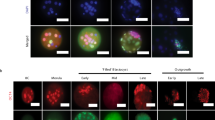Abstract
Purpose
To explore a simple method of establishing pluripotent human embryonic stem cell (hESC) lines from single blastomeres of low-quality (LQ) embryos.
Methods
Blastomeres were isolated from normally fertilized, day-3 pre-implantation LQ embryos by dissolving of the zona pellucida and were then plated directly onto inactivated human foreskin fibroblasts. The subsequent culture was identical to that used to derive a hESC line from the inner cell mass of a blastocyst. The established hESC lines were passaged and characterized.
Results
Two hESC lines were produced by culturing the blastomeres individually in a hESC culture system (hESC-CS). Both of the hESC lines maintained a normal 46-chromosome XY karyotype, expressed stemness markers, and showed a pluripotent phenotype, including the ability to differentiate into all three germ layers in vitro and in vivo.
Conclusions
The blastomeres of LQ embryos have a developmental capacity that necessitates prolonged culture. Plating of blastomeres from LQ embryos directly into the hESC-CS is a feasible method for deriving hESC lines.








Similar content being viewed by others
References
Verfaillie CM, Pera MF, Lansdorp PM. Stem cells: hype and reality. Hematology Am Soc Hematol Educ Program. 2002:369–91
Sinawat S. Potential applications of human embryonic stem cells. J Med Assoc Thai. 2007;90(6):1253–8.
Ponsaerts P, van Tendeloo VF, Jorens PG, Berneman ZN, van Bockstaele DR. Current challenges in human embryonic stem cell research: directed differentiation and transplantation tolerance. J Biol Regul Homeost Agents. 2004;18(3–4):347–51.
Hardy K, Martin KL, Leese HJ, Winston RM, Handyside AH. Human preimplantation development in vitro is not adversely affected by biopsy at the 8-cell stage. Hum Reprod. 1990;5(6):708–14.
Klimanskaya I, Chung Y, Becker S, Lu SJ, Lanza R. Human embryonic stem cell lines derived from single blastomeres. Nature. 2006;444(7118):481–5. doi:10.1038/nature05142.
Chung Y, Klimanskaya I, Becker S, Li T, Maserati M, Lu SJ, et al. Human embryonic stem cell lines generated without embryo destruction. Cell Stem Cell. 2008;2(2):113–7. doi:10.1016/j.stem.2007.12.013.
Ilic D, Giritharan G, Zdravkovic T, Caceres E, Genbacev O, Fisher SJ, et al. Derivation of human embryonic stem cell lines from biopsied blastomeres on human feeders with minimal exposure to xenomaterials. Stem Cells Dev. 2009;18(9):1343–50. doi:10.1089/scd.2008.0416.
Geens M, Mateizel I, Sermon K, De Rycke M, Spits C, Cauffman G, et al. Human embryonic stem cell lines derived from single blastomeres of two 4-cell stage embryos. Hum Reprod. 2009;24(11):2709–17. doi:10.1093/humrep/dep262.
Steer CV, Mills CL, Tan SL, Campbell S, Edwards RG. The cumulative embryo score: a predictive embryo scoring technique to select the optimal number of embryos to transfer in an in-vitro fertilization and embryo transfer programme. Hum Reprod. 1992;7(1):117–9.
The Istanbul consensus workshop on embryo assessment: proceedings of an expert meeting. Hum Reprod. 2011;26(6):1270–83. doi:10.1093/humrep/der037.
Panula S, Reijo PR. Preparation of human foreskin fibroblasts for human embryonic stem cell culture. CSH Protoc. 2008;2008:t5043.
Mai Q, Yu Y, Li T, Wang L, Chen MJ, Huang SZ, et al. Derivation of human embryonic stem cell lines from parthenogenetic blastocysts. Cell Res. 2007;17(12):1008–19. doi:10.1038/cr.2007.102.
Zhang X, Stojkovic P, Przyborski S, Cooke M, Armstrong L, Lako M, et al. Derivation of human embryonic stem cells from developing and arrested embryos. Stem Cells. 2006;24(12):2669–76. doi:10.1634/stemcells.2006-0377.
Gavrilov S, Prosser RW, Khalid I, MacDonald J, Sauer MV, Landry DW, et al. Non-viable human embryos as a source of viable cells for embryonic stem cell derivation. Reprod Biomed Online. 2009;18(2):301–8.
Veiga A, Calderon G, Barri PN, Coroleu B. Pregnancy after the replacement of a frozen-thawed embryo with less than 50 % intact blastomeres. Hum Reprod. 1987;2(4):321–3.
Van de Velde H, Cauffman G, Tournaye H, Devroey P, Liebaers I. The four blastomeres of a 4-cell stage human embryo are able to develop individually into blastocysts with inner cell mass and trophectoderm. Hum Reprod. 2008;23(8):1742–7. doi:10.1093/humrep/den190.
Johnson MH, McConnell JM. Lineage allocation and cell polarity during mouse embryogenesis. Semin Cell Dev Biol. 2004;15(5):583–97. doi:10.1016/j.semcdb.2004.04.002.
Johnson MH. Human ES, cells and a blastocyst from one embryo: exciting science but conflicting ethics? Cell Stem Cell. 2008;2(2):103–4. doi:10.1016/j.stem.2008.01.021.
Chung Y, Klimanskaya I, Becker S, Marh J, Lu SJ, Johnson J, et al. Embryonic and extraembryonic stem cell lines derived from single mouse blastomeres. Nature. 2006;439(7073):216–9. doi:10.1038/nature04277.
Acknowledgments
This study was supported by grants from the Key Laboratory of Guangdong Province and the National Natural Science Foundation of China (No. 30801239). We are grateful to Pingping Hong for cell culture and Chenhui Ding for proofreading the manuscript.
Author information
Authors and Affiliations
Corresponding author
Additional information
Capsule Plating single blastomeres directly into a hESC culture system is an innovative, simple method for deriving hESC lines in vitro.
Gang Yang and Qingyun Mai contributed equally to this work.
Rights and permissions
About this article
Cite this article
Yang, G., Mai, Q., Li, T. et al. Derivation of human embryonic stem cell lines from single blastomeres of low-quality embryos by direct plating. J Assist Reprod Genet 30, 953–961 (2013). https://doi.org/10.1007/s10815-013-0042-x
Received:
Accepted:
Published:
Issue Date:
DOI: https://doi.org/10.1007/s10815-013-0042-x




